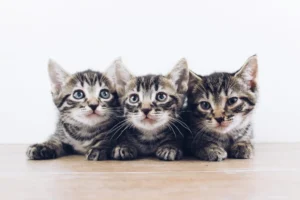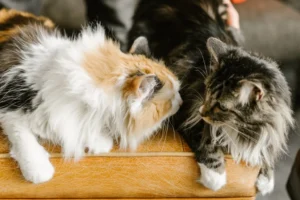Have you ever wondered why cats and dogs seem to have a natural aversion to one another? Despite many households having both as pets, these two popular animals often struggle to get along.
In this blog post, we’ll explore the reasons behind the age-old rivalry between cats and dogs and uncover why their relationship can be so challenging.
Different Instincts and Behaviors
Cats and dogs have different instincts and behaviors that can often lead to conflicts between them. For instance, cats are typically more solitary animals, preferring to have their own space and territory. On the other hand, dogs are pack animals and are more likely to seek social interaction with both humans and other animals.
When a cat feels threatened or stressed, its instinct is to retreat or hide until it feels safe again. This can be misinterpreted by a dog as a sign of weakness or fear, triggering the dog’s prey drive instinct to chase after the cat. Similarly, a dog’s playful behavior, such as jumping or barking, may intimidate a cat who sees it as a threat rather than friendly play.
Understanding these natural instincts can help pet owners create a harmonious environment for both cats and dogs in the same household. Providing separate spaces for each pet to retreat to when they need alone time can help reduce conflicts and ensure they feel safe and secure.
Lack of Socialization
Early socialization plays a crucial role in shaping the behavior of cats and dogs and can greatly impact their ability to coexist peacefully. Kittens and puppies that are exposed to a variety of experiences, environments, and other animals during their critical socialization period are more likely to develop social skills and learn how to interact with different species.
If a cat or dog lacks adequate socialization during this critical period, they may struggle to understand and communicate effectively with each other. For example, an unsocialized cat may not know how to read a dog’s body language or vocal cues, leading to misunderstandings and potential conflicts.
To help foster positive interactions between cats and dogs, pet owners should gradually introduce them to each other in a controlled environment and provide positive reinforcement for calm and friendly behavior. Patience, consistency, and supervision are key to helping cats and dogs build trust and understanding with each other over time.
Territorial Tensions
When it comes to territorial tensions, cats and dogs have their own unique ways of claiming their space. Cats are known for their strong territorial instincts, often marking their territory with scent to establish boundaries. On the other hand, dogs may see an invasion of their space as a threat, particularly if they feel their territory is being encroached upon. This clash of territorial behavior can lead to conflicts between the two species, as each tries to assert dominance in their own way. It’s essential for pet owners to provide separate spaces for their cats and dogs to help reduce territorial tension and create a harmonious environment at home.
Communication Barrier
Communication plays a significant role in how cats and dogs interact with each other. While cats are more subtle in their communication, using body language, vocalizations, and scent to convey their feelings, dogs are more vocal and expressive, relying heavily on barking, growling, and body postures to communicate. This difference in communication styles can often lead to misunderstandings between the two species. For example, a dog’s playful approach may be misinterpreted as aggression by a cat, causing tension between them. To help bridge this communication barrier, pet owners can learn to interpret their pets’ body language and vocal cues to better understand their needs and prevent conflicts before they escalate.
Unique Insight: Providing separate feeding and sleeping areas for cats and dogs can also help reduce conflicts over resources, such as food and sleeping spots, which can be a common trigger for disagreements between the two species. By giving each pet their own designated space, owners can minimize the chances of territorial disputes and promote a more peaceful coexistence in the household.
Prey Drive vs. Hunting Instinct
Dogs have an innate prey drive, which is their urge to chase and capture prey. On the other hand, cats are wired with a strong hunting instinct to stalk and pounce on their prey. When these two different instincts collide, it can lead to tension and aggression between cats and dogs. Dogs may see cats as potential prey, triggering their chase instinct, while cats may view dogs as a threat to their hunting grounds, causing them to act defensively.
To help manage this issue, it’s crucial to provide outlets for each pet’s natural behaviors. Engaging your dog in regular play sessions that mimic hunting activities can help fulfill their prey drive in a more controlled setting. Similarly, offering interactive toys for your cat to stalk and pounce on can redirect their hunting instinct away from the dog. By satisfying these instincts in a controlled environment, you can reduce the likelihood of conflict between your furry friends.
Size Disparities
The size disparities between cats and dogs can often play a significant role in their interactions. Dogs are typically larger and more physically powerful than cats, creating a power imbalance that can lead to conflicts. When a playful interaction escalates, the size and strength difference can make cats feel intimidated or threatened, prompting defensive behaviors such as hissing, swatting, or even scratching.
To help manage size-related conflicts, it’s essential to create safe spaces for both pets to retreat to when they need a break. Providing elevated spaces for cats to perch on, such as cat trees or shelves, can give them a sense of security and control in the environment. Additionally, supervising their interactions closely and intervening before tensions escalate can help prevent size-related conflicts from occurring.
Tips for Managing Cats and Dogs Interactions:
- Slow Introduction: Gradually introduce your cat and dog in a controlled environment to build positive associations.
- Supervised Interactions: Monitor their interactions closely, especially during the initial stages of their relationship.
- Separate Resources: Ensure each pet has their own food, water bowls, and litter boxes to prevent resource guarding.
By understanding the dynamics of prey drive and hunting instinct as well as the impact of size disparities, you can take proactive steps to foster a harmonious relationship between your beloved pets.
Environmental Enrichment
Creating a harmonious environment for cats and dogs in a shared household can help minimize conflict and promote peaceful coexistence. Here are some tips to help you achieve this:
1. Separate Resting Areas : Cats and dogs have different preferences when it comes to resting spots. Providing separate, comfortable sleeping areas for each pet can prevent territorial disputes.
2. Vertical Space : Cats love to climb and perch up high, while dogs prefer lower levels. Utilize cat trees, shelves, or window perches to give your feline friend a space away from the ground where they can observe from a safe distance.
3. Hideaways : Cats appreciate hiding spots to retreat to when they need some quiet time. Offer cat condos, covered beds, or even cardboard boxes for them to escape to when feeling overwhelmed.
4. Interactive Play : Engage both pets in interactive play sessions that involve toys they can enjoy together, fostering positive interactions and bonding.
5. Individual Time : Make sure to spend one-on-one time with each pet to prevent jealousy and ensure their individual needs are being met.
Seeking Professional Help
Sometimes, despite your best efforts, cats and dogs may still struggle to get along. In such cases, seeking the assistance of a professional animal behaviorist can be beneficial. Here’s when you might consider reaching out for help:
1. Persistent Aggression : If there are recurring incidents of aggression between your pets that are escalating in severity, it’s crucial to seek professional guidance to address the root cause.
2. Stressful Situations : Major life changes such as moving to a new house, introducing a new pet, or a new family member can disrupt the harmony between cats and dogs. A behaviorist can help ease the transition.
3. Lack of Progress : If you’ve tried various strategies to improve the relationship between your pets with little to no success, a professional can provide tailored guidance to address specific issues.
4. Medical Concerns : Sometimes, underlying health issues can contribute to behavioral problems in pets. A behaviorist can work alongside your veterinarian to rule out any potential medical causes.
5. Behavioral Modification : A professional can create a customized behavior modification plan to address aggression, fear, or other problematic behaviors that may be hindering the relationship between your pets.
In challenging situations where cats and dogs struggle to get along, seeking the expertise of a professional can make a significant difference in improving their relationship.
Fun Facts About Cats and Dogs
Cats and dogs have been known to have a tumultuous relationship, but understanding their unique behaviors can shed light on why they might not always get along. Did you know that cats are more independent by nature, while dogs tend to be more social and pack-oriented? This fundamental difference in their social structures can sometimes lead to conflict when they interact with each other. Additionally, cats are natural hunters with a strong prey drive, while dogs have a strong instinct to chase. This can result in misunderstandings and potential conflicts between the two species.
Here’s a unique insight: Cats and dogs communicate in different ways. Cats use body language, such as tail flicking and purring, to express their emotions, while dogs rely more on vocalizations and facial expressions. This difference in communication styles can sometimes lead to misunderstandings between the two animals, contributing to their difficulty in getting along.
Surprising Facts About Cats and Dogs:
- Cats are crepuscular: Cats are most active during dawn and dusk, which can clash with a dog’s diurnal nature.
- Dogs are pack animals: Dogs often see the household as their pack, which can be challenging for aloof cats.
- Cats have sharp claws: Cats can use their claws defensively, which may trigger a defensive reaction in dogs.
- Dogs have a strong sense of smell: Dogs rely heavily on scent, which can overwhelm a cat’s sensitive nose.
- Cats are obligate carnivores: Cats have specific dietary needs that may not align with a dog’s omnivorous diet.
By understanding these intriguing facts about cats and dogs, we can gain insight into why they may not always see eye to eye and how we can help facilitate better interactions between them.
Alex, a passionate animal lover, has experience in training and understanding animal behavior. As a proud pet parent to two dogs and three cats, he founded AnimalReport.net to share insights from animal experts and expand his knowledge of the animal kingdom.









